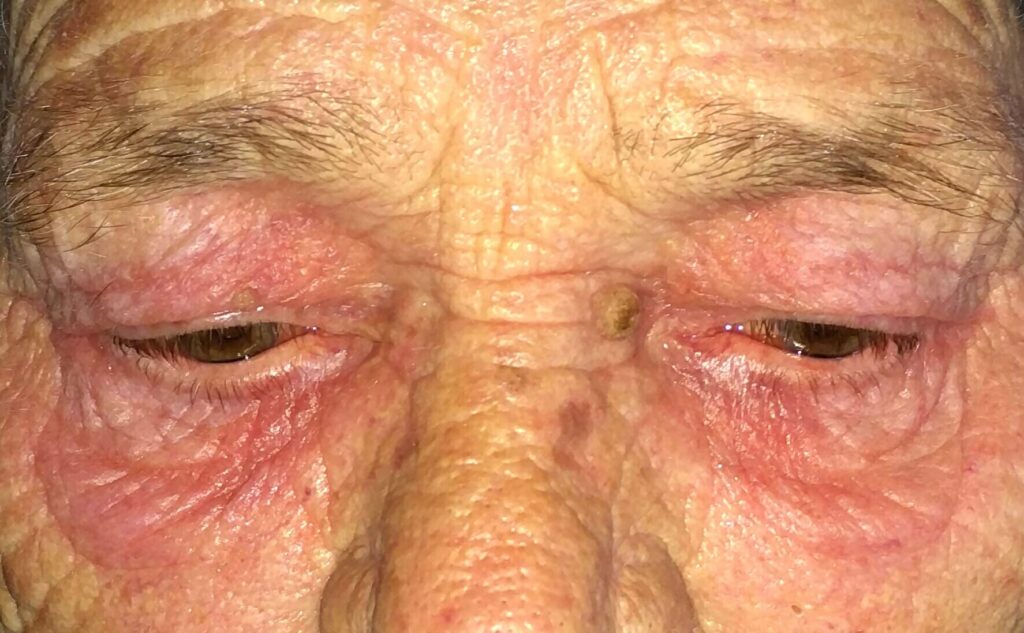Ocular rosacea is a chronic, inflammatory eye condition associated with facial rosacea. It primarily affects the eyes and eyelids, often presenting as redness, burning, dryness, and irritation. Left untreated, ocular rosacea can lead to serious complications, including corneal damage and vision impairment. Early diagnosis and tailored treatment are crucial in managing symptoms and preventing progression.

Understanding the Link Between Facial and Ocular Rosacea
Rosacea is a systemic inflammatory skin disorder that affects the central face, often characterized by erythema, telangiectasia, papules, and pustules. In up to 58% of patients with facial rosacea, ocular involvement may occur. In some cases, ocular rosacea precedes cutaneous signs, complicating diagnosis.
Key Causes and Risk Factors
While the precise etiology of ocular rosacea remains unknown, several contributing factors have been identified:
- Immune system dysregulation leading to chronic inflammation
- Vascular abnormalities increasing blood flow to the skin and eyes
- Microbial overgrowth, particularly Demodex folliculorum mites
- Environmental triggers, such as UV light, heat, spicy foods, alcohol
- Genetics, with higher prevalence in fair-skinned individuals of Northern European descent
Other risk enhancers include stress, hormonal changes, and skin barrier dysfunction.
Clinical Symptoms of Ocular Rosacea
The symptoms of ocular rosacea are variable in severity and may mimic other ocular surface disorders. Common signs include:
- Red, bloodshot eyesBurning or stinging sensation
- Dryness or gritty feeling
- Itchy, inflamed eyelids (blepharitis)
- Light sensitivity (photophobia)
- Blurred vision or watery eyes
- Recurrent styes or chalazia
- Corneal complications such as ulcers or scarring in severe cases
Diagnostic Process for Ocular Rosacea
Accurate diagnosis relies on a thorough clinical evaluation combining ocular and dermatological assessment:
Clinical Evaluation:
- Slit-lamp examination to assess lid margin inflammation, meibomian gland dysfunction, and conjunctival redness
- Tear film breakup time (TBUT) and Schirmer test to evaluate tear quality and volume
- Dermatological review for co-existing facial rosacea signs
Differential Diagnosis:
Ocular rosacea must be differentiated from:
- Allergic conjunctivitis
- Blepharitis of other etiology (seborrheic, bacterial)
- Dry eye syndrome unrelated to rosacea
- Autoimmune conditions such as Sjögren’s syndrome or lupus
Comprehensive Treatment Options for Ocular Rosacea
Effective treatment of ocular rosacea requires a multidisciplinary approach targeting inflammation, meibomian gland dysfunction, and ocular surface restoration.
1. Eyelid Hygiene and Warm Compresses
- Daily eyelid cleansing using gentle cleansers or hypochlorous acid sprays
- Warm compresses improve meibomian gland function and unclog oil glands
2. Artificial Tears and Lubricants
- Preservative-free artificial tears reduce dryness and irritation
- Ointments for night-time lubrication
3. Topical Medications
- Topical cyclosporine (Restasis) to reduce ocular surface inflammation
- Azithromycin eye drops for anti-inflammatory and antimicrobial effects
4. Oral Medications
- Doxycycline (40–100 mg/day) or minocycline as first-line oral antibiotics
- Low-dose isotretinoin in resistant cases under specialist supervision
5. Advanced Interventions
- IPL (Intense Pulsed Light) therapy targeting abnormal vessels and meibomian gland dysfunction
- Meibomian gland expression by ophthalmologist
- Punctal plugs in cases of severe dry eye
6. Facial Rosacea Management
- Treating facial rosacea with topical metronidazole, ivermectin, or brimonidine can reduce ocular flares
- Dermatological collaboration improves long-term outcomes
Lifestyle Modifications and Preventive Strategies
Controlling ocular rosacea involves identifying and avoiding personal triggers. Preventive recommendations include:
- Sun protection using sunglasses and broad-spectrum sunscreen
- Avoiding spicy foods, alcohol, and hot beverages
- Stress management through relaxation techniques
- Maintaining hydration for tear film health
- Limiting screen time to reduce eye strain
- Using humidifiers in dry indoor environments
Long-Term Outlook and Complications
Ocular rosacea is a chronic relapsing condition that requires ongoing maintenance. With early diagnosis and comprehensive treatment, symptoms can be managed effectively, and progression to vision-threatening complications can be avoided.
Potential Complications if Left Untreated:
- Chronic blepharitis and meibomian gland atrophy
- Corneal neovascularization and scarring
- Corneal perforation in severe ulceration
- Secondary infections
Frequently Asked Questions:
Q1: Can ocular rosacea occur without facial symptoms?
Yes, ocular rosacea can present independently, especially in early stages, making diagnosis more challenging.
Q2: Is ocular rosacea contagious?
No, it is not contagious. It is an inflammatory condition, not an infection.
Q3: Can children develop ocular rosacea?
Although rare, pediatric ocular rosacea can occur and may be misdiagnosed as recurrent styes or conjunctivitis.
Q4: How long does it take to see improvement with treatment?
Noticeable improvement typically occurs within 4–8 weeks of consistent therapy, but maintenance is required to prevent recurrence.
Q5: Are contact lenses safe for people with ocular rosacea?
Contact lenses may aggravate symptoms and should be avoided during flares. Daily disposables are preferable if necessary.
Ocular rosacea is a complex, multifactorial disease that bridges dermatology and ophthalmology. By recognizing its early signs and implementing targeted, sustained treatment plans, we can prevent complications and improve quality of life. Patient education, lifestyle adaptation, and interdisciplinary care are essential pillars in controlling this chronic ocular condition.